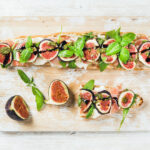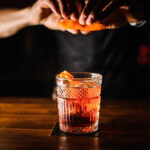
A recent trip to Italy reminded me of the pleasures of sipping an apéritif before dinner. A drinking tradition in Europe, an apéritif is a light, dry, low alcohol beverage served before a meal. It’s never too sweet or heavy since its intention is to stimulate the appetite without impacting one’s taste buds for enjoying wine with a meal. The word apéritif is derived from the Latin word “aperire,” translated “to open,” as in to prime the palate.
Both my palate and curiosity were stimulated. I enjoy cocktails, but one issue has been the levels of alcohol and sugar in many drinks; the combination of the two can lead to a pounding headache. That’s why the concept of a cocktail that is light and refreshing and low in alcohol is especially appealing.
I’m always on the search for healthier options in what I eat or drink. So, I did a little further digging with the goal of finding great taste with lower alcohol and potentially less sugar.
A Little Pharmacological History
Health-focused drinks prepared with alcohol are nothing new. Many cultures used them in folk medicine; distilled alcohol served as a natural preservative and antiseptic. Before the days of modern medicine, pharmacists would concoct herbal elixirs, tinctures, bitters and tonics laced with distilled alcohol to help cure various ills.

In his book, Apothecary Cocktails- Restorative Drinks from Yesterday and Today, author Warren Bobrow writes, “The earliest known pharmacist-prepared treatments called for fragile herbs, flowers, fruits and even vegetables-along with substantial quantities of aforementioned alcohol, which prevented them from rotting, and preserved their healing qualities.”
These days, many bartenders are creating drinks that focus on better ingredients and lower proof to better serve their health-conscious customer. Technically, one cannot call them “healthy cocktails” since they contain alcohol. But, much like reworking many of the foods we enjoy to make them a little bit better for you- think pizza, burgers and creamy foods- there are ways to tweak a drink. Here are five:
Use Fresh Ingredients and Better Quality Products
“Using better ingredients starts with the quality of the spirit and mixers and incorporating fresh fruits, vegetables and herbs,” notes Hunter Austin, a beverage consultant for restaurants in Pennsylvania.
Many packaged mixers are loaded with sugar, calories and even preservatives. While there are better purées, syrups, tonics and sodas on the market, you need to know the brand and read the ingredients on the label to get the complete picture. Bartenders have jumped into the mix, so to speak, to make ingredient-driven products. Examples include Jim Meehan (PDT, New York)’s East Imperial Pink Grapefruit Soda and Andy Ricker (Pok Pok and Whiskey Soda Lounge, Portland)’s SṐM drinking vinegar.

However, nothing beats using fresh fruits,vegetables, herbs and spices to add a burst of flavor. Just about any homemade fruit or vegetable juice serves as a healthier base for a cocktail than a sugary mixer. Hunter Austin’s Blondie Mary, made from blanched golden tomatoes puréed with white Worcestershire Sauce, Tabasco, jalapeño chili, fresh lemon, lime, sea salt and dill is so fresh you could drink it straight as a soup without adding the vodka.
Mind your ABVs (alcohol by volume)
A “session beverage” refers to an easy-drinking beer or cocktail that is lower in alcohol by volume (ABV), also called “low-proof.” The reference started in Great Britain during the first World War when pubs limited drinking periods to two sessions to keep customers from overconsuming.
Drew Lazor, author of Session Cocktails-Low Alcohol Drinks for Any Occasion, explains, “While there isn’t a hard-and-fast, industry-wide definition of a session cocktail, for the purposes of our book, it is defined as a drink that has no more than 3/4 ounce of a strong spirit (e.g., whiskey, vodka, tequila, rum). The remainder of the recipe is filled out with distinct lower-proof alternatives (think, vermouth, sherry, liqueurs, amari) and non-alcoholic elements. The portion control aspect of building a session cocktail is really the secret. You’re still chasing big flavor, just at a lower proof.”
One of the better-known low-proof warm-weather cocktails is the Pimm’s Cup. This British classic is made with Pimm’s No 1 liqueur (2 oz.), a fresh cucumber slice (1), seltzer (3 oz.), a sliced strawberry, a slice of orange, and fresh lime and lemon juice (1/2 oz. each) mixed, strained and served over ice in a Collins glass. Variations of this recipe substitute ginger-ale, prosecco or sparkling wine for the fizz. Pimm’s Cups served with strawberries and clotted crème is a tradition at the Wimbledon Tennis Tournament each summer.
Give it a Spritz
Many champagnes and sparkling wines have lower ABV than some still wines which makes them easy to drink as apéritifs and to use as a base for a cocktail. In France, one may sip a Kir Royale, a mix of Crème de Cassis (1.5 oz.) topped with chilled Champagne (4.5 oz.) served in a flute. Visit the Veneto in Italy and you’ll see a sea of orange drinks at bars and cafés. The Aperol Spritz is made with the Italian liqueur, Aperol (1.5 oz) and the local Prosecco (3 oz) with a splash of club soda. Its sister drink is Campari and soda.
Prosecco serves as a nice low alcohol base for many cocktail variations. In her book, Prosecco Made Me Do It, author Amy Zavatto shares a twist on the traditional Negroni called the Sbagliato, a blend of Campari (1 oz.), sweet vermouth (1 oz.) and brut-style Prosecco (2 oz.) served over ice in a rocks glass and garnished with orange peel.
Sip a Shrub
Shrubs are refreshing, tangy cocktails made with fruit-laced drinking vinegars, served over ice. In the 17th and 18th centuries, consuming vinegar, which is rich in polyphenols and antioxidants, was a common antidote for treating many ailments, including dropsy, croup and stomach ache. English seafarers consumed citrus fruit to ward off diseases like scurvy during sailings. Mixing vinegar into the fruit prevented the latter from rotting since there was no refrigeration.
The origin of the name “shrub” is Arabic where “sharab” means “to drink.” It most likely had its roots in Persia with the Skeanjabin, a warm weather drink made with honey, vinegar and water with a touch of mint.

Consider a Cobbler
Sherry, a fortified wine, is often enjoyed as an apéritif and with tapas in its native Spain. It is also the base for the Cobbler, a cocktail born in American in the 1800s when drinking sherry was popular. It’s a refreshing combination of sherry, a dash of simple syrup, seltzer and muddled fruit -usually citrus or berries -poured over crushed ice.
In Apothecary Cocktails, Warren Bobrow writes, “In days of yore, pharmacists prescribed sherry as a nerve tonic or as an antidote to insomnia.” He adds, about the sherry cobbler, “In eighteenth century England, the fizzy mixture had a reputation for curing foul moods.”
Some cobbler recipes are made with drier styles of sherry, such as a nutty amontillado, but using a slightly sweeter style of sherry, like oloroso, can negate the need for adding much sugar. While there are many cobbler recipes using harder spirits, sherry has about half the ABV of most spirits, an average fifteen to twenty percent.
Less is More
A big appeal for spritzes, shrubs and cobblers is they are simple. They don’t require many ingredients, another factor that can add calories to a cocktail. The focus is on fresh flavor and texture which can be satiating.
Above all, taking the less is more approach is always the healthiest one with mindful moderation, savoring every sip slowly and with pleasure.
Looking for more inspiration? Check out these cocktail books:
Session Cocktails: Low Alcohol Drinks for Any Occasion by Drew Lazor and the Editors of PUNCH (Ten Speed Press)
Apothecary Cocktails: Restorative Drinks from Yesterday and Today by Warren Bobrow (Fairwind Press)
Prosecco Made Me Do It: 60 Seriously Sparkling Cocktails by Amy Zavatto (Andrews McMeel Publishing)
Edible Cocktails: From Garden to Glass- Seasonal Cocktails with a Fresh Twist by Nathalie Bovis, The Liquid Muse (Adams Media)

Pimm’s Cup
Adapted by Dan Greenbaum, Diamond Reef, Brooklyn, NY- from Session Cocktails: Low-Alcohol Drinks for Any Occasion
Makes: 1 cocktail
Ingredients:
1 strawberry, halved
3 slices cucumber
½ ounce simple syrup*
2 ounces Pimm’s No 1 liqueur
½ ounce lime juice
½ ounce lemon juice
Soda water
Combine the strawberry, cucumber and simple syrup in a cocktail shaker and use a muddler to lightly crush them together. Add the remaining ingredients, along with ice and shake until chilled. Fine strain into a Collins glass filled with ice, then top with soda. Garnish with the strawberry and mint sprig.
Simple Syrup and Another Sweet Option (from Session Cocktails)
For simple syrup
Combine 1 cup sugar and 1 cup water in a small pot over very low heat. Stir constantly until sugar is dissolved. Remove from heat and let cool completely. Transfer to a glass container and store in the refrigerator for up to two weeks. Makes 1 ¼ cups.
Honey syrup (Natural honey has antioxidant qualities)
Combine ¾ cup honey and ¼ cup hot water in a heatproof container and stir to combine. Store in the refrigerator for one month. Makes 2 cups.

Melanie Young co-hosts the national weekly radio show, The Connected Table LIVE! Wednesdays 2 pm EST on W4CY Radio and podcast permanently to iHeart.com and the free iHeart App.



